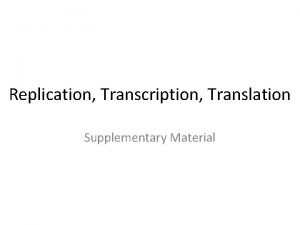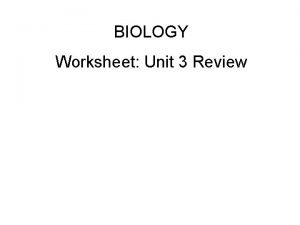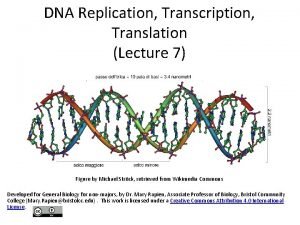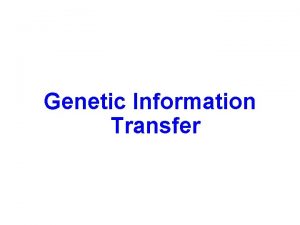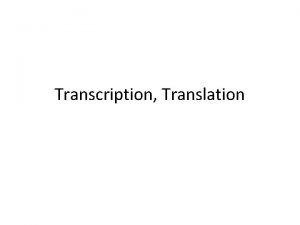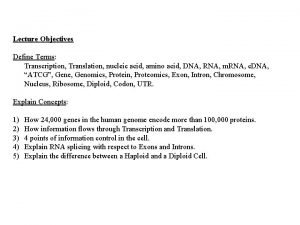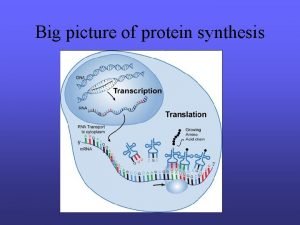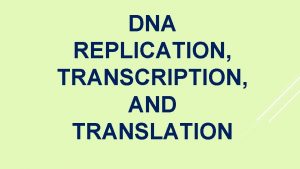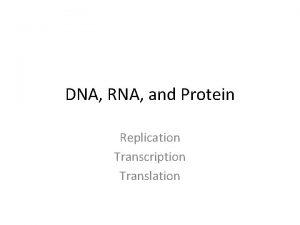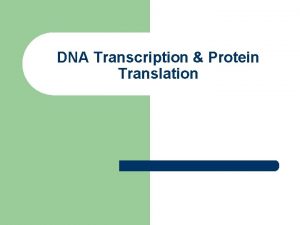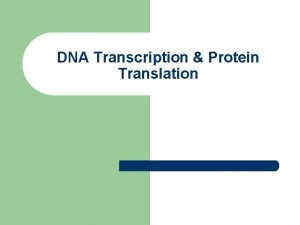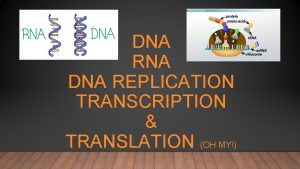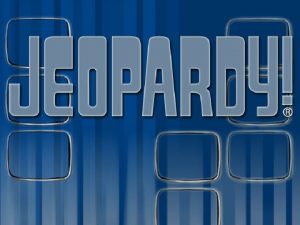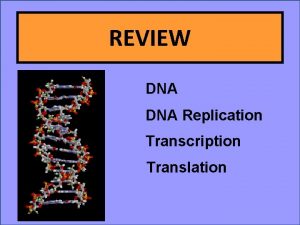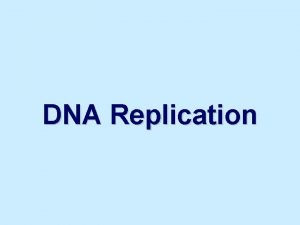2 7 DNA Replication Transcription Translation DNA Replication














- Slides: 14

2. 7 DNA Replication, Transcription & Translation

DNA Replication Understandings: Ø Replication is semi-conservative & depends on complementary base pairing Ø Helicase unwinds double helix & separates strands by breaking H bonds Ø DNA polymerase links nucleotides to form new strand, using pre-existing strand as template Applications: Ø Use of Taq DNA polymerase to produce multiple copies of DNA rapidly by PCR Nature of Science: Obtaining evidence Skills: for scientific theories: ØAnalysis of Meselson & Stahl’s Meselson & Stahl obtained evidence results to obtain support for the semi-conservative replication theory of semi-conservative of DNA. replication of DNA

Understanding: Replication is semi-conservative & depends on complementary base pairing • Semi-conservative = both DNA strands produced from replication composed of one original strand a newly synthesized strand • Complementary base pairing = one base always pairs with another (it is the principle that ensures 2 identical DNA molecules)

Nature of Science: Obtaining evidence for theory of semi-conservative replication • Matt Meselsohn & Frank Stahl’s 1958 experiment: How does DNA replicate? • Grew E. coli in medium with 15 N, then transferred bacteria to medium with 14 N. Samples of E. coli taken & separated by density gradient centrifugation (heavier molecules settle further down tube than lighter ones).

Evidence for the semi-conservative model:

Understanding: Helicase unwinds double helix & separates strands by breaking H bonds (requires ATP)

DNA Polymerase

DNA Replication animation http: //highered. mheducation. com/sites/0072943696/student_view 0/c hapter 3/animation__dna_replication__quiz_1_. html

Polymerase chain reaction

PCR

Transcription/Translation Understandings: Ø Transcription is the synthesis of m. RNA copied from the DNA base sequences by RNA polymerase. Ø Translation is synthesis of polypeptides on ribosomes. Ø The amino acid sequence of polypeptides is determined by m. RNA according to the genetic code. Ø Codons of 3 bases on m. RNA correspond to one amino acid in a polypeptide. Ø Translation depends on complementary base pairing between codons on m. RNA & anticodons on t. RNA. Applications: Ø Production of human insulin in bacteria as an example of the universality of the genetic code allowing gene transfer between species. Skills: ØUse genetic code to deduce which codon(s) corresponds to which amino acid. ØUse a table of m. RNA codons and their corresponding amino acids to deduce the sequence of amino acids coded by a short m. RNA strand of known base sequence. ØDeducing the DNA base sequence for the m. RNA strand.

• http: //highered. mheducation. com/sites/0072507470/student_view 0 /chapter 3/animation__mrna_synthesis__transcription___quiz_1_. ht ml • http: //highered. mheducation. com/sites/0072507470/student_view 0 /chapter 3/animation__how_translation_works. html

Application: Production of human insulin in bacteria as an example of the universality of the genetic code allowing gene transfer between species. • Most diabetics use genetically-modified E. coli (bacteria), yeast (fungus), or safflower (plant) • Bacteria, fungus, plant – all are genetically altered so they produce HUMAN insulin • Possible because humans, bacteria, fungus, plants (and most other organisms) all use the SAME genetic code the code is UNIVERSAL! • Genetic engineers can transfer genes between different species!

 Dna replication transcription and translation
Dna replication transcription and translation Bioflix activity dna replication nucleotide pairing
Bioflix activity dna replication nucleotide pairing Transcription translation replication
Transcription translation replication Transcription translation replication
Transcription translation replication Translation
Translation Semiconservative replication
Semiconservative replication Transcription and translation coloring
Transcription and translation coloring Dna transcription and translation
Dna transcription and translation Dna rna protein synthesis homework #2 dna replication
Dna rna protein synthesis homework #2 dna replication Dna polymerase function in dna replication
Dna polymerase function in dna replication Venn diagram dna and rna
Venn diagram dna and rna Picture of protein synthesis
Picture of protein synthesis Comparing dna and rna worksheet answers
Comparing dna and rna worksheet answers Translation transcription
Translation transcription Protein synthesis splicing
Protein synthesis splicing


